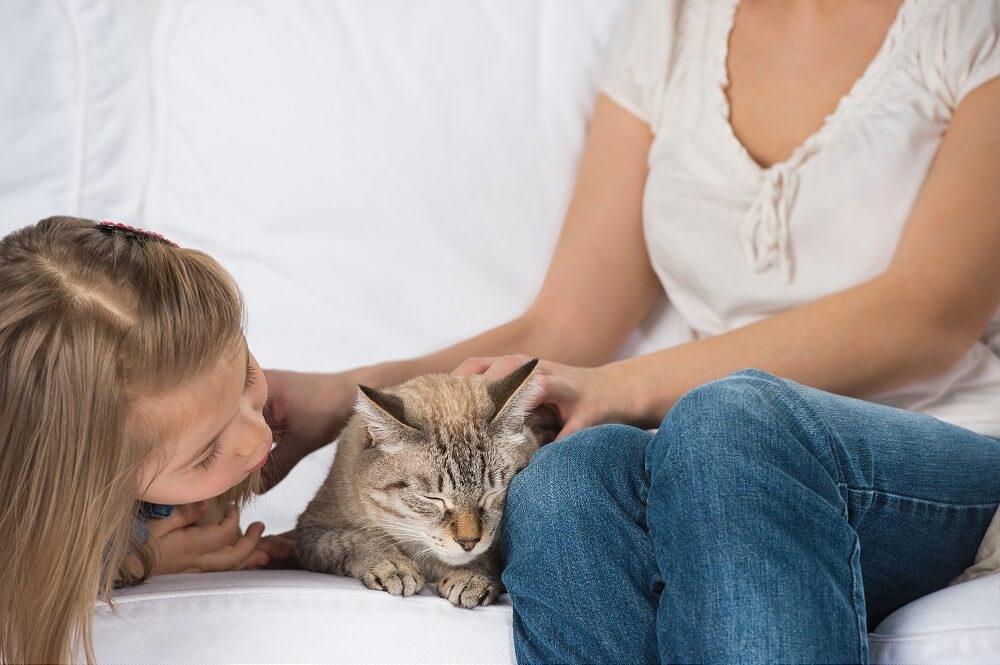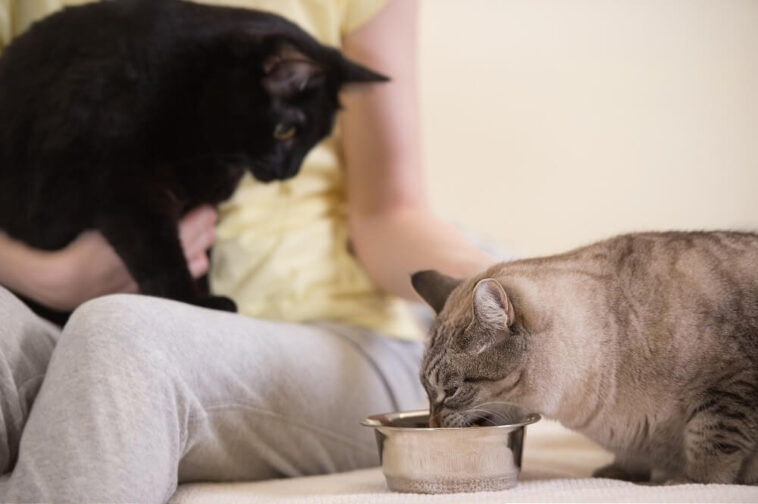Welcoming a new cat into your home is an exhilarating and heartwarming experience. The prospect of a furry companion paddling around, exploring their new territory, and eventually becoming a part of your family evokes a sense of joy and anticipation. However, amidst this excitement, lies the need for a smooth transition—a phase that, for many cats, can be both thrilling and overwhelming.
This article aims to guide cat owners through the process of introducing a new feline member to their household. While the journey promises immense happiness, it’s crucial to recognize the challenges that accompany this transition. Creating an environment where your new cat feels secure, comfortable, and welcome is key to ensuring a harmonious integration. Through ten carefully crafted tips, we’ll explore the strategies and considerations essential for fostering a seamless transition, allowing your new companion to feel at ease and at home from the very start.
Tip 1: Preparation and Creating a Safe Space
When welcoming a new cat, establishing a designated area within your home holds immense significance. This safe haven serves as the initial point of comfort, aiding in the cat’s adjustment to their new surroundings. Here’s a breakdown of the essentials and their roles in creating this safe space:
Significance of a Designated Area:
The designated space acts as a sanctuary for the cat, offering a sense of security amidst the unfamiliar. This area serves as a retreat, allowing the cat to acclimate gradually, easing the stress of transitioning to a new environment.
Essential Items for the Space:
- Food and Water Dishes: Providing easily accessible food and water is crucial for the cat’s well-being.
- Litter Box: A clean and strategically placed litter box encourages the cat to maintain good hygiene habits.
- Comfortable Bedding: A cozy bed or blanket offers a place for the cat to rest and feel secure.
- Toys: Toys provide mental stimulation and a source of entertainment, aiding in the adjustment process by alleviating stress and boredom.
This dedicated area offers the cat a predictable environment, allowing them to adapt at their own pace while feeling secure in their new home. By incorporating these essential items, you provide the foundations for a smooth and comfortable transition for your new feline companion.
Tip 2: Gradual Introduction to Other Pets
Introducing a new cat to your existing furry family members requires a strategic and gradual approach. The process of familiarizing your new cat with other pets involves two key methods: scent swapping and controlled introductions.

Process of Introducing the New Cat:
Start by utilizing scent swapping, an effective technique where blankets or toys that carry the scent of the new cat are exchanged with those of the existing pets. This process helps in creating a sense of familiarity without direct interaction. The exchanged scents allow each pet to become acquainted with the other’s presence, laying the groundwork for a smoother introduction.
Controlled Introductions for Familiarity:
Once the pets have become familiar with each other’s scents, it’s time for controlled introductions. This involves gradual, supervised meetings between the pets, initially in short and controlled sessions. Observing their body language and behaviors during these interactions is crucial to ensure a stress-free introduction.
By gradually introducing scents and then overseeing controlled interactions, you establish a foundation for a harmonious relationship between your new cat and existing pets. This methodical approach fosters familiarity, reduces stress, and increases the likelihood of a positive and gradual integration into your pet family.
Tip 3: Establishing a Calm Environment
Creating a tranquil atmosphere is paramount when introducing a new cat to your home. Minimizing stress-inducing factors and ensuring a calm, quiet environment significantly aids in your cat’s adjustment.
Reducing Stress-Inducing Factors:
Diminish stress triggers by controlling loud noises and sudden movements. Cats are sensitive to their surroundings, and a calm environment eases their transition, allowing them to feel secure and less overwhelmed by the new setting.

Strategies for a Serene Atmosphere:
- Gradual Acclimatization: Introduce your cat to one room at a time, gradually expanding their territory. This step-by-step approach lessens the chances of overwhelming your new feline friend.
- Consistent Routine: Stick to a regular routine for feeding, play, and rest. Predictability in their daily schedule provides a sense of security and stability.
- Comforting Spaces: Create cozy spots for your cat to retreat to when feeling anxious. Elevated perches or hiding spots can offer a sense of safety.
By minimizing stress-inducing factors and implementing strategies for a calm environment, you pave the way for a more seamless and comfortable transition for your new cat. This approach helps them acclimate gradually and feel at ease in their new home.
Tip 4: Practicing Patience
Adapting to a new environment varies for every cat, and it’s crucial to acknowledge and embrace this diversity in adjustment times. Encouraging patience is key to allowing your new cat to set its own pace in adapting to the surroundings.
Understanding Varying Adjustment Times:
Every cat possesses a unique temperament and history, impacting their adaptation period. Some cats might boldly explore their new space, while others might be more hesitant, taking days, weeks, or even longer to feel entirely at ease. This diversity in adjustment times is perfectly normal and requires a patient and understanding approach.
Encouraging a Patient Approach:
It’s essential to provide a supportive environment that allows the cat to acclimate at its own speed. Avoid rushing or forcing interactions, as this can cause undue stress. Instead, offer gentle encouragement and reassurance, allowing the cat to explore and adapt in its own time.
By acknowledging and respecting the varying adjustment times and practicing patience, you create a supportive environment that promotes your cat’s comfort and confidence in their new home. Embracing this patience allows for a smoother and stress-free transition for your new feline companion.
Tip 5: Encouraging Socialization and Bonding
Building a strong bond with your new cat is essential for their well-being and comfort in their new home. Here are effective ways to foster socialization and create a lasting bond:
Ways to Bond with Your Cat:
- Treats and Rewards: Use treats as positive reinforcement when your cat displays desirable behavior or when they make progress in their adjustment. This encourages trust and reinforces positive associations.
- Gentle Affection: Spend quality time with your cat, offering gentle petting, soothing words, and cuddles. This helps them feel secure and builds a connection based on trust.
- Play and Interaction: Engage in interactive play sessions using toys or games that your cat enjoys. Play is not just entertaining but also an excellent way to bond and understand your cat’s preferences.

Role of Positive Associations:
Creating positive associations is pivotal in the cat’s comfort and trust-building process. By associating their new environment with pleasant experiences—such as treats, affectionate interactions, and enjoyable playtime—you establish a positive connection. This helps in building trust and a strong bond between you and your cat.
Encouraging socialization and bonding through these methods fosters a sense of security and affection, ultimately aiding in the cat’s adjustment and happiness in their new home. These positive interactions lay the foundation for a strong and enduring bond between you and your feline companion.
Tip 6: Consistency in Routine
Establishing and maintaining a consistent routine is crucial for a cat’s well-being and their adaptation to a new environment. A steady and predictable schedule for feeding, play, and rest offers several advantages:
Significance of Routine:
Consistency provides a sense of security and predictability, essential for a cat’s comfort. A set routine helps in reducing stress and anxiety, as cats thrive in stable environments. Knowing what to expect fosters a feeling of safety, promoting a smoother adjustment.
Importance of a Consistent Schedule:
- Feeding Time: Establish regular feeding times, serving meals at the same hours each day. Consistency in feeding schedules helps regulate the cat’s appetite and creates a sense of security around mealtime.
- Play Sessions: Set aside specific periods for play and interaction. Engaging in play at consistent times allows the cat to anticipate and look forward to these activities, promoting mental stimulation and bonding.
- Rest and Sleep: Cats appreciate a quiet space for rest. Providing a comfortable resting area and maintaining a calm environment during their designated rest times aids in their relaxation and well-being.
By maintaining a consistent routine, you provide a structured and stable environment that is conducive to your cat’s comfort and adjustment. Predictability in their daily activities contributes to their sense of security, ultimately facilitating a smoother transition into their new home.
Tip 7: Supervised Exploration
Guiding your cat through a gradual exploration of their new environment is essential for a successful transition. Here’s how to manage supervised exploration and expand your cat’s territory safely:
Transitioning Beyond Safe Spaces:
After the initial settling period, gradually introduce supervised exploration beyond the designated safe area. Start by allowing your cat to venture into adjacent rooms while being under your watchful eye. Supervision is vital to ensure their safety and comfort as they encounter new spaces.
Gradual Territory Expansion Tips:
- Room-by-Room Approach: Introduce one new room at a time, allowing the cat to become familiar with each area before moving on to the next.
- Positive Reinforcement: Encourage exploration by placing familiar items, such as their bed or toys, in the new areas. This aids in creating a sense of familiarity and comfort.
- Slow and Steady: Allow the cat to set the pace. If they show signs of stress or hesitation, backtrack and provide reassurance before proceeding further.
Supervised exploration, done gradually and patiently, aids in the cat’s acclimatization to the entire home. By expanding their territory under supervision and offering a sense of security, you facilitate a confident and comfortable exploration of their new surroundings. This methodical approach minimizes stress and helps your cat feel at ease as they familiarize themselves with their new home.
Tip 8: Cat-Proofing Your Home
Ensuring a safe and cat-friendly environment is paramount for your new feline family member. Cat-proofing your home involves identifying potential hazards and taking measures to create a secure space for your cat to roam freely without risks.
Identifying Potential Hazards:
- Household Chemicals: Secure and store household cleaners, chemicals, and medications in cabinets or areas inaccessible to your cat.
- Plants: Remove toxic plants or place them out of reach. Some common plants like lilies, aloe vera, or certain ferns can be harmful to cats if ingested.
- Cords and Wires: Conceal or secure electrical cords to prevent chewing or entanglement, reducing the risk of injury.

Steps for a Safe Environment:
- Secure Windows and Balconies: Install secure screens or barriers to prevent falls or escapes, ensuring your cat’s safety.
- Small Object Removal: Remove small items that could be swallowed, such as rubber bands or small toys, to prevent choking hazards.
- Hide Small Spaces: Seal off or block small spaces where a cat could get stuck or hide, such as gaps behind furniture.
Creating a cat-safe environment not only prevents accidents but also promotes a stress-free and secure atmosphere for your new cat. By addressing potential hazards and securing your home, you provide a space where your cat can explore and play without the risk of injury or ingestion of harmful substances. This cat-proofing process contributes to a safe and comfortable environment for your furry friend.
Tip 9: Veterinary Check-Up
After welcoming your new cat into your home, prioritizing a visit to the veterinarian is crucial. This initial vet check-up is fundamental for your cat’s health and well-being, ensuring a smooth transition into their new environment.
The Importance of a Vet Visit:
- Health Assessment: A veterinarian can conduct a comprehensive health evaluation to ensure your cat is in good health. This check-up helps in identifying any underlying health issues that might need attention.
- Vaccinations and Preventive Care: Discussing and administering necessary vaccinations protects your cat from common diseases, providing essential preventive care.

Significance of Health Check-Ups:
Regular vet visits play a pivotal role in maintaining your cat’s well-being:
- Early Detection: Timely vet visits can help in early detection of any health concerns, enabling prompt treatment and care.
- Establishing a Relationship: Building a relationship with a vet helps in seeking advice and guidance for your cat’s ongoing health needs.
Ensuring a vet check-up shortly after bringing your new cat home not only supports their immediate health but also sets the foundation for their long-term well-being. Regular vet care guarantees your cat’s health and helps in addressing any potential health issues early, providing a healthy and happy life for your feline companion.
Tip 10: Observation and Responsiveness
Observing your new cat’s behavior and promptly addressing any signs of stress or health issues is crucial in ensuring their well-being and a successful transition to their new home.
Observation of Cat’s Behavior:
- Body Language: Watch for signs of stress or discomfort in their body language, such as flattened ears, excessive hiding, or unusual aggression.
- Eating and Drinking Habits: Monitor their eating and drinking habits for any sudden changes that might indicate underlying health issues.
Prompt Response to Signs of Stress or Health Issues:
- Creating Comfort: Address any signs of stress by providing a calm and secure environment, offering familiar items like bedding or toys.
- Vet Consultation: If you notice concerning behaviors or health changes, consult a veterinarian promptly to address and resolve any potential issues.
Regular observation and swift responsiveness to any indications of stress or health issues contribute significantly to your cat’s well-being.
Conclusion
In welcoming a new cat into your home, ensuring a smooth transition is key to their well-being and contentment. The ten tips provided serve as a guide to foster a comfortable adjustment and establish a nurturing environment for your new feline companion.
A seamless transition paves the way for a happy and stress-free integration of your cat into their new surroundings. It minimizes anxiety, allowing them to acclimate gradually, fostering a sense of security and familiarity.
Reiteration of the Ten Tips:
- Preparation and Safe Space: Creating a designated area.
- Gradual Introduction to Other Pets: Utilizing scent swapping and controlled introductions.
- Establishing a Calm Environment: Minimizing stress-inducing factors.
- Practicing Patience: Allowing varying adjustment times for different cats.
- Encouraging Socialization and Bonding: Using treats, affection, and play to build trust.
- Consistency in Routine: Providing stability and predictability.
- Supervised Exploration: Gradually expanding the cat’s territory under supervision.
- Cat-Proofing Your Home: Ensuring a safe environment.
- Veterinary Check-Up: Emphasizing the necessity of health assessments.
- Observation and Responsiveness: Attentiveness to the cat’s behavior and needs.
By adhering to these tips, you lay the foundation for a secure, welcoming, and comfortable environment for your new cat. Your attentiveness and dedication play a significant role in their successful adjustment, ensuring a lifetime of happiness and well-being in their new home.







GIPHY App Key not set. Please check settings